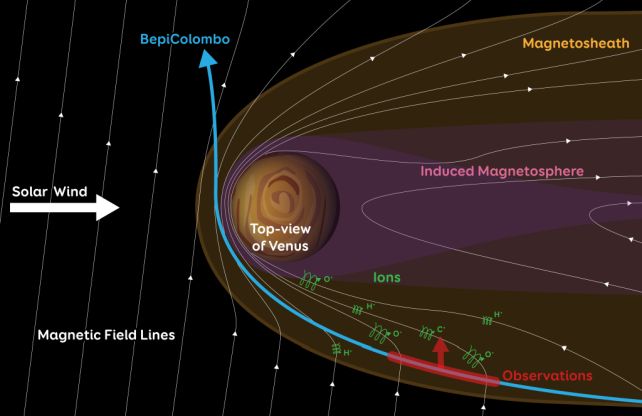Planetary atmospheres are typically leaky things. Think about it – with no impenetrable barrier to hold it back against the void, some of it is bound to seep away and dissipate into the very tenuous medium in the between parts of space.
Earth loses about 90 tonnes of atmospheric material every day. That's not enough to make a dent, but it does give us a few clues about why some of the other planets are the way they are. Venus, for example, is thought to have once been a temperate world like Earth, with liquid water on its surface. Now, it's a scorching hell-planet choked in clouds of carbon dioxide that rain sulfuric acid.
Now, a spacecraft whipping past Earth's evil twin has detected atoms of carbon and oxygen leaking from Venus, in a discovery that when combined with previous findings on the loss of hydrogen could yield clues as to the planet's startling transformation.
"Characterizing the loss of heavy ions and understanding the escape mechanisms at Venus is crucial to understand how the planet's atmosphere has evolved and how it has lost all its water," says astrophysicist Dominique Delcourt of the National Centre for Scientific Research (CNRS) in France.
In spite of being our nearest orbital neighbor and the most similar planet to Earth in the Solar System, there's not much in-situ information about Venus. There is just one dedicated mission studying Venus up close at the moment – the Akatsuki orbiter, which has been studying Venus's atmosphere since 2010. But spacecraft on other missions are getting glimpses of Venus as they go about their other business.
BepiColombo is a joint mission between the Japanese Aerospace Exploration Agency and the European Space Agency to study Mercury. The course of its mission included two close flybys of Venus, one in 2020 and the other in 2021; the second of which taking the probe into a part of Venus' magnetic environment that hasn't been explored before.

Now, Venus doesn't have a magnetic field that's generated inside the planet like Earth does. Rather, its magnetic field is the result of a series of interactions between charged particles in Venus's upper atmosphere and magnetic fields and moving ions in the solar wind. The result is a weak 'sphere' of magnetism that forms a sort of teardrop shape, with the tail streaming away with the solar wind.
Draped around the magnetosphere is the magnetosheath, between the outer boundary of the magnetosphere and compressed material called a bow shock. This is what BepiColombo flew through, between Venus and the Sun, almost skimming the planet. And its instruments detected oxygen and carbon, somehow accelerated sufficiently to escape Venus's gravity.
"This is the first time that positively charged carbon ions have been observed escaping from Venus's atmosphere," says astrophysicist Lina Hadid of CNRS.
"These are heavy ions that are usually slow moving, so we are still trying to understand the mechanisms that are at play. It may be that an electrostatic 'wind' is lifting them away from the planet, or they could be accelerated through centrifugal processes."
At least three missions are in the works to study Venus in the near future, which will hopefully shed light on many remaining questions. These include the escape mechanism for carbon, whether the planet is still volcanically active, and the burning question about whether life could be lurking among its clouds.
And, of course, how it evolved from a world that may have been once so similar to our own home planet.
"Recent results suggest that the atmospheric escape from Venus cannot fully explain the loss of its historical water content," says astrophysicist Moa Persson of the Swedish Institute of Space Physics. "This study is an important step to uncover the truth about the historical evolution of the Venusian atmosphere, and upcoming missions will help fill in many gaps."
The team's research has been published in Nature Astronomy.
